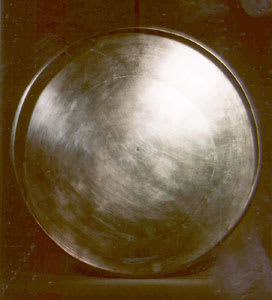Late Roman/Early Byzantine Silver Platter, 300 CE - 500 CE
Silver
48.3 x 3.8 cm
19 x 1 1/2 in
19 x 1 1/2 in
X.0164
This shallow round unadorned platter rests on a low foot-ring located near the outer edge of the piece. The bottom has a centering point with a shallow groove around it,...
This shallow round unadorned platter rests on a low foot-ring located near the outer edge of the piece. The bottom has a centering point with a shallow groove around it, while the interior has a similar centering point with a shallow groove near the outer edge, over the foot ring. Judging from these marks, it is safe to presume that this piece was hammered out of a single piece of silver and then turned on a lathe to smooth the surfaces during the final stages of manufacture, thereby producing the concentric grooves seen on the interior and exterior. The plain surface, lacking any decoration, and the large size indicate that this plate was likely used as a serving platter. Roman mosaics, specifically those uncovered in Antioch, depict similar silver platters being used as serving dishes.
In this respect, this platter would not appear out of place in a modern house. Today, sets of finely polished silverware are still essential when entertaining. We can assume that anyone lucky enough to be invited to a dinner party hosted by the well-to-do family that originally owned this work would have been quite impressed by the inherent luxury and masterful workmanship of this dish. We can picture it covered with an assortment of tasty treats that the guest would have nibbled on during the transitional period from the end of the Roman Empire to the beginning of the Byzantine era.
In this respect, this platter would not appear out of place in a modern house. Today, sets of finely polished silverware are still essential when entertaining. We can assume that anyone lucky enough to be invited to a dinner party hosted by the well-to-do family that originally owned this work would have been quite impressed by the inherent luxury and masterful workmanship of this dish. We can picture it covered with an assortment of tasty treats that the guest would have nibbled on during the transitional period from the end of the Roman Empire to the beginning of the Byzantine era.
32
of
32
